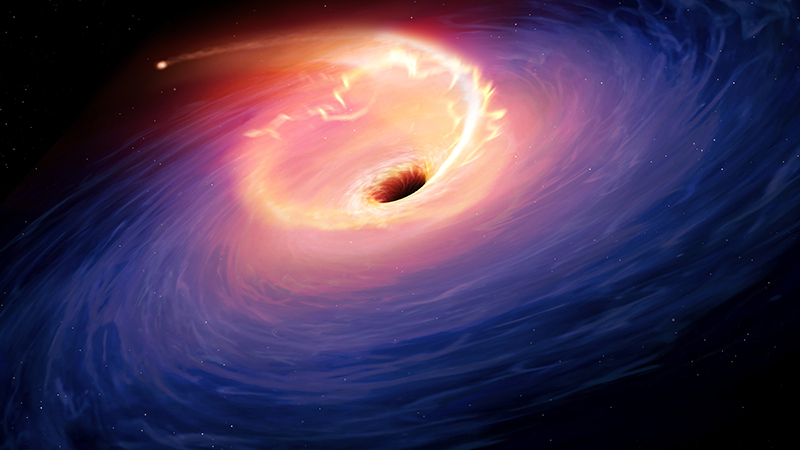2023-04-25 パデュー大学
 “Scary Barbie” is the affectionate nickname astronomers are calling one of the most energetic and luminous transients ever observed: a supermassive black hole tearing apart a massive star, as in this illustration. (Mark Garlick/Science Photo Library via Getty Images)
“Scary Barbie” is the affectionate nickname astronomers are calling one of the most energetic and luminous transients ever observed: a supermassive black hole tearing apart a massive star, as in this illustration. (Mark Garlick/Science Photo Library via Getty Images)
この星は、ZTF20abrbeieというランダムな名前が割り当てられ、愛情を込めて「Scary Barbie」と呼ばれています。この星は、超巨大ブラックホールによって引き裂かれた星であり、最も明るく、エネルギッシュで長持ちする変光星の一つです。これは、天文学者が今まで見た中で最もエネルギッシュな現象であり、最も輝かしいものです。
<関連情報>
- https://www.purdue.edu/newsroom/releases/2023/Q2/uncovering-a-stars-demise-supermassive-black-hole-tears-apart-a-giant-star-in-a-display-brighter-more-energetic-and-longer-lasting-than-any-observed-before.html
- https://arxiv.org/abs/2302.10932
怖いバービー:z = 0.995の銀河系を持たない、非常に高エネルギーで長時間の潮汐崩壊事象の候補者
Scary Barbie: An Extremely Energetic, Long-Duration Tidal Disruption Event Candidate Without a Detected Host Galaxy at z = 0.995
Bhagya M. Subrayan, Dan Milisavljevic, Ryan Chornock, Raffaella Margutti, Kate D. Alexander, Vandana Ramakrishnan, Paul C. Duffell, Danielle A. Dickinson, Kyoung-Soo Lee, Dimitrios Giannios, Geoffery Lentner, Mark Linvill, Braden Garretson, Matthew J. Graham, Daniel Stern, Daniel Brethauer, Tien Duong, Wynn Jacobson-Galán, Natalie LeBaron, David Matthews, Huei Sears, Padma Venkatraman
arXiv Submitted on 21 Feb 2023
DOi:https://doi.org/10.48550/arXiv.2302.10932
We report multi-wavelength observations and characterization of the ultraluminous transient AT 2021lwx (ZTF20abrbeie; aka “Barbie”) identified in the alert stream of the Zwicky Transient Facility (ZTF) using a Recommender Engine For Intelligent Transient Tracking (REFITT) filter on the ANTARES alert broker. From a spectroscopically measured redshift of 0.995, we estimate a peak observed pseudo-bolometric luminosity of log (Lmax/[erg/s]) = 45.7 from slowly fading ztf-g and ztf-r light curves spanning over 1000 observer-frame days. The host galaxy is not detected in archival Pan-STARRS observations (g>23.3 mag), implying a lower limit to the outburst amplitude of more than 5 mag relative to the quiescent host galaxy. Optical spectra from Lick and Keck Observatories exhibit strong emission lines with narrow cores from the H Balmer series and ultraviolet semi-forbidden lines of Si III] λ1892, C III] λ1909, and C II] λ2325. Typical nebular lines in AGN spectra from ions such as [O II] and [O III] are not detected. These spectral features, along with the smooth light curve that is unlike most AGN flaring activity, and the luminosity that exceeds any observed or theorized supernova, lead us to conclude that AT 2021lwx is most likely an extreme tidal disruption event (TDE). Modeling of ZTF photometry with MOSFiT suggests that the TDE was between a ≈14M⊙ star and a supermassive black hole of mass MBH∼ 108M⊙. Continued monitoring of the still-evolving light curve along with deep imaging of the field once AT 2021lwx has faded can test this hypothesis and potentially detect the host galaxy.



